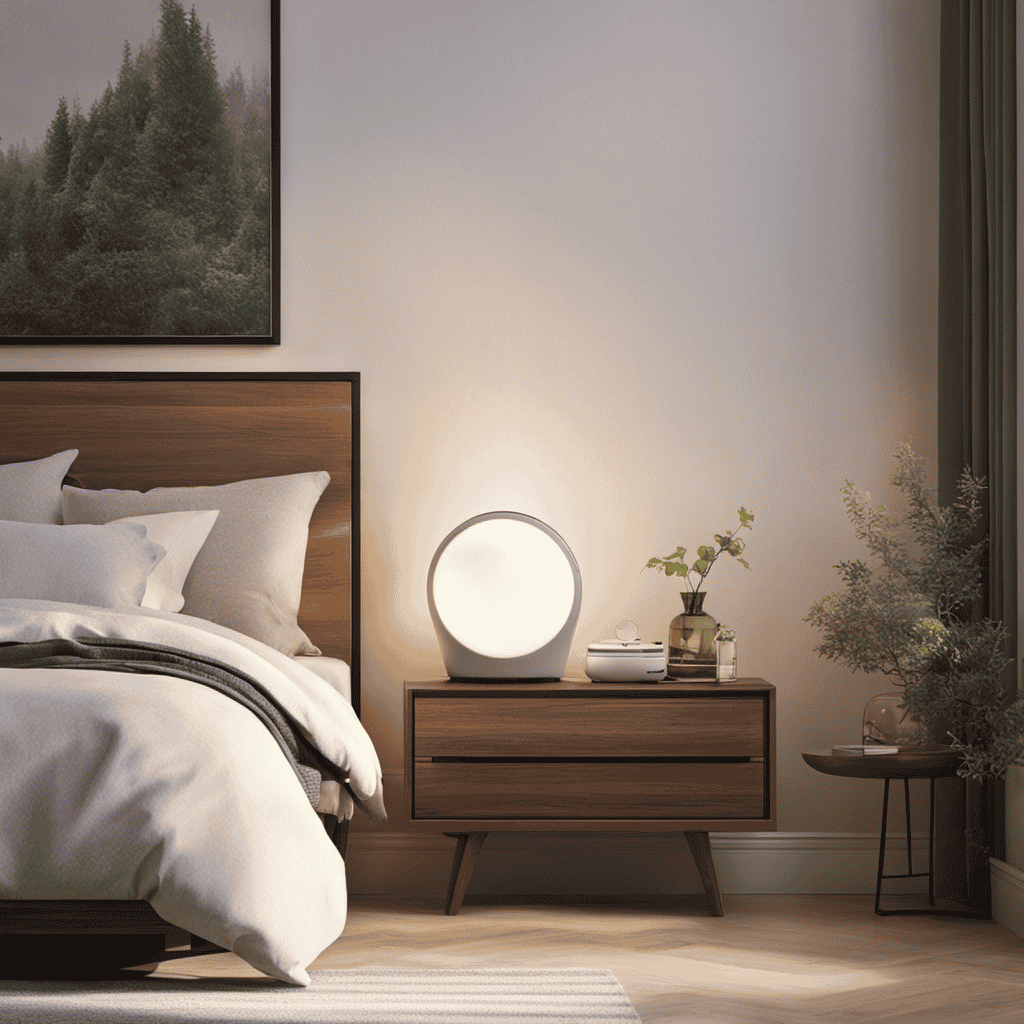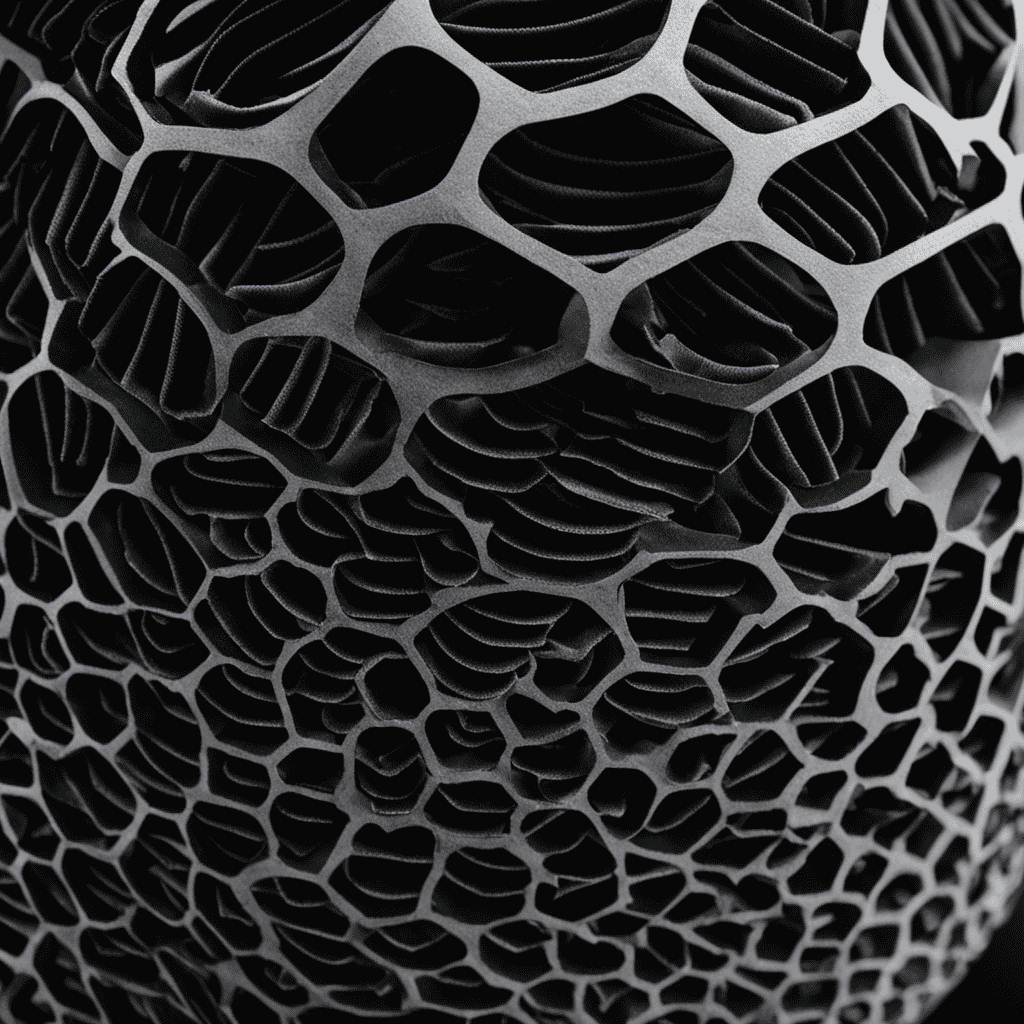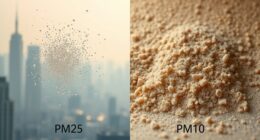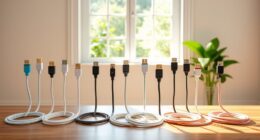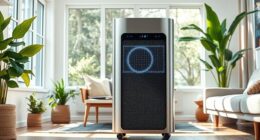Did you know that indoor air can be up to five times more polluted than outdoor air? As someone who suffers from allergies, I understand the importance of having clean, allergen-free air in my home.
That’s why I decided to do some research on air purifiers and how long they need to run to effectively eliminate allergens. In this article, I will share the findings of my research and provide you with valuable insights on how to maintain allergen-free air using air purifiers.
Key Takeaways
- Indoor air can be up to five times more polluted than outdoor air.
- Air purifiers greatly improve indoor air quality.
- Continuous use of air purifiers can provide relief for those with allergies.
- Factors like room size and air purifier placement affect efficiency.
The Importance of Air Purifiers in Eliminating Allergens
Air purifiers are essential in eliminating allergens and can greatly improve indoor air quality.
For individuals with pet allergies, air purifiers can be especially beneficial. These devices work by filtering out pet dander, which is a common allergen that can cause symptoms such as sneezing, itching, and difficulty breathing. By continuously running an air purifier in a room where pets spend most of their time, pet owners can significantly reduce the amount of allergens in the air, providing relief for those with pet allergies.
Additionally, air purifiers can also benefit asthma sufferers. Asthma is a chronic respiratory condition that can be triggered by various allergens, including dust mites, pollen, and pet dander. By effectively removing these allergens from the air, air purifiers can help reduce asthma symptoms and improve overall respiratory health.
Understanding the Different Types of Air Purifiers Available
When it comes to air purifiers, it’s important to know the various types available in order to make an informed decision. Here are three different types of air purifiers, along with their pros and cons:
-
HEPA (High Efficiency Particulate Air) Filters: These filters are highly effective at capturing small particles like dust, pollen, and pet dander. However, they may not be as effective against gases and odors.
-
Activated Carbon Filters: These filters are excellent at removing odors, gases, and chemicals from the air. However, they may not be as effective at capturing larger particles like dust and allergens.
-
UV-C Air Purifiers: These purifiers use ultraviolet light to kill bacteria, viruses, and mold spores. However, they may not be as effective at capturing larger particles or removing odors.
When choosing an air purifier for different allergens, consider factors such as the size of the room, the specific allergens you want to target, and your budget.
Factors to Consider When Choosing an Air Purifier for Allergen Elimination
When it comes to choosing an air purifier for allergen elimination, there are two key factors that should be considered:
-
Room size and capacity: This determines the effectiveness of the air purifier in terms of cleaning the air in a given space.
-
Filter type and efficiency: This determines how well the air purifier can capture and remove allergens from the air.
Taking these factors into account is crucial in selecting the right air purifier to effectively eliminate allergens in your home or office.
Room Size and Capacity
To effectively eliminate allergens, make sure your room size matches the capacity of your air purifier. Room layout and air purifier placement play a crucial role in maximizing the efficiency of allergen elimination. Here are three key points to consider:
-
Evaluate the size of your room: Measure the square footage of the room where you intend to use the air purifier. This will help you determine the appropriate purifier size and capacity needed for optimal results.
-
Consider the layout of your room: Take note of any obstacles or furniture that may obstruct the airflow. It’s important to place the air purifier in an area where it can circulate the air effectively and reach all corners of the room.
-
Optimal air purifier placement: Position the air purifier at least a few feet away from walls and furniture to ensure unrestricted airflow. Additionally, placing the purifier in a central location within the room can help distribute clean air evenly.
Following these guidelines for room size and air purifier placement will help ensure that your air purifier effectively eliminates allergens, providing you with cleaner and healthier indoor air.
Filter Type and Efficiency
For optimal results, make sure you choose the right filter type and ensure its efficiency in capturing and removing harmful particles from your indoor air. When it comes to air purifier maintenance, selecting the appropriate filter is crucial. There are different types of filters available, each with its own advantages and disadvantages. To help you make an informed decision, here is a table outlining the common filter types and their efficiency in capturing various particles:
| Filter Type | Efficiency in Capturing | Advantages | Disadvantages |
|---|---|---|---|
| HEPA | 99.97% of particles | Highly effective at removing allergens and pollutants | May need frequent replacement |
| Activated Carbon | Gases, odors, and chemicals | Removes odors and harmful chemicals | Less effective at capturing particles |
| Ionizers | Particles and allergens | Generates negative ions to attract particles | Ozone emissions may be a concern |
The Recommended Duration for Running an Air Purifier to Effectively Eliminate Allergens
When it comes to eliminating allergens, it is important to consider the optimal runtime for an air purifier. Through extensive research and analysis, experts have determined that the recommended duration for running an air purifier to effectively eliminate allergens is typically between 8 to 12 hours per day.
This timeframe allows the purifier to continuously filter and clean the air, ensuring the removal of allergens and providing a healthier environment for individuals with allergies.
Optimal Purifier Runtime
You’ll want to consider the optimal runtime for your air purifier to effectively eliminate allergens. Based on extensive research and studies, here are three key factors to take into account when determining the duration for running your air purifier:
-
Room Size: Larger rooms require longer purifier runtime to effectively clean the air. Consider the square footage of your space when deciding how long to run the purifier.
-
Allergen Level: If your indoor environment has higher allergen levels, such as during allergy seasons or in homes with pets, you may need to run the purifier for a longer duration to achieve optimal results.
-
Continuous Operation: To ensure consistent elimination of allergens, it is recommended to run the air purifier continuously. This allows the purifier to continuously filter the air and maintain clean, allergen-free surroundings.
By considering these factors and running your air purifier for the optimal duration, you can effectively eliminate allergens and improve the air quality in your home.
Now, let’s explore the timeline for allergen elimination and how long it takes for the air purifier to show noticeable results.
Allergen Elimination Timeline
To effectively improve the air quality in your home, it’s important to understand the timeline for eliminating allergens with your air purifier. The allergen elimination timeline can vary depending on factors such as the size of your space, the level of allergens present, and the efficiency of your air purifier. However, research suggests that running your air purifier consistently for a certain amount of time can significantly reduce allergens in your home. Here is a table to help you understand the recommended purifier runtime based on the size of your space:
| Room Size | Recommended Purifier Runtime |
|---|---|
| Small (up to 300 sq ft) | 4-6 hours per day |
| Medium (300-600 sq ft) | 8-10 hours per day |
| Large (over 600 sq ft) | 12-16 hours per day |
Following these guidelines can help ensure that your air purifier effectively eliminates allergens and improves the air quality in your home. Now, let’s discuss how often you should run your air purifier to maintain allergen-free air.
How Often Should You Run Your Air Purifier to Maintain Allergen-Free Air
If you want to maintain allergen-free air, it’s important to run your air purifier regularly. But how often should you run it? Here are some guidelines to help you determine the optimal running time and frequency of use:
-
Run your air purifier continuously: To ensure the highest level of allergen elimination, it’s recommended to run your air purifier 24/7. This constant operation will help capture and remove allergens from the air effectively.
-
Increase usage during peak allergy seasons: If you suffer from seasonal allergies, consider increasing the running time of your air purifier during those times. This will help combat the influx of allergens and provide relief from allergy symptoms.
-
Customize based on room size and air quality: The size of your room and the air quality in your specific environment can also impact the frequency of air purifier usage. Larger rooms may require longer running times, while rooms with poor air quality may benefit from more frequent use.
By following these guidelines, you can ensure that your air purifier is running at the optimal times and frequencies to maintain allergen-free air.
Now, let’s explore the impact of room size on the effectiveness of air purifiers in eliminating allergens.
The Impact of Room Size on the Effectiveness of Air Purifiers in Eliminating Allergens
In my research on air purifiers, I have discovered that the impact of these devices on respiratory health can be significant. Air purifiers work by removing airborne particles, such as allergens, from the air, which can greatly improve indoor air quality. This is especially important for individuals with respiratory conditions, such as asthma or allergies, as these particles can trigger symptoms and exacerbate their conditions. Studies have shown that using air purifiers in homes or offices can lead to a reduction in respiratory symptoms and improved lung function.
However, it is also important to consider the cost effectiveness of air purifiers. While they can provide significant benefits to respiratory health, they can also be expensive to purchase and maintain. It is essential to choose an air purifier that is suitable for the room size, as using one that is too small for the space may not effectively eliminate allergens. Additionally, regular filter replacements and energy consumption should be taken into account when assessing the cost effectiveness of these devices.
Overall, the impact of air purifiers on respiratory health is positive, but careful consideration of their cost effectiveness is necessary.
Other Measures to Complement the Use of Air Purifiers for Allergen Elimination
When it comes to finding relief from allergies, air purifiers can be an effective tool. However, it’s important to consider additional measures for comprehensive allergy relief.
In this discussion, we will explore the concept of effective allergen elimination, taking into account the use of air purifiers and alternative methods to achieve optimal results.
Additional Allergy Relief
To get additional allergy relief, you could try using a nasal spray or taking antihistamines. These options can help alleviate symptoms such as sneezing, itching, and a runny nose.
In addition to these traditional medications, there are also natural remedies for allergies that you can explore. Here are three options to consider:
-
Quercetin: This plant pigment found in fruits and vegetables has been shown to have antihistamine properties, which can help reduce allergy symptoms.
-
Butterbur: This herb has been used for centuries to treat allergies and asthma. It may work by reducing inflammation and blocking the release of histamines.
-
Probiotics: These beneficial bacteria can help strengthen the immune system and reduce allergic reactions.
By incorporating these natural remedies into your allergy prevention routine, you may experience additional relief. However, it’s important to consult with a healthcare professional before trying any new treatment.
Transitioning into the next section, let’s now explore effective ways to eliminate allergens from your environment.
Effective Allergen Elimination
One effective way to reduce allergens in your environment is by regularly cleaning and vacuuming your home. By eliminating dust, pet dander, and other allergens from surfaces and carpets, you can significantly reduce your exposure to these triggers. Additionally, there are other allergen removal techniques that can further enhance the air quality in your home. One such technique is using an air purifier. An air purifier works by filtering out allergens and other particles from the air, helping to create a cleaner and healthier environment. To illustrate the effectiveness of this technique, here is a table comparing different allergen removal techniques:
| Technique | Effectiveness |
|---|---|
| Regular cleaning | Moderate |
| Vacuuming | High |
| Air purifier | Very high |
Air Purifiers Vs Alternatives?
If you’re considering alternatives, comparing different techniques for reducing allergens can help you decide which method is most effective. When it comes to eliminating allergens, two popular options are air purifiers and natural remedies. Here’s a comparison between the two:
-
Air Purifiers:
- Use filters to capture and eliminate allergens from the air.
- Can effectively reduce allergens indoors.
- Provide immediate relief by removing allergens from the environment.
-
Natural Remedies:
- Include practices like regular cleaning, dust mite covers, and maintaining optimal humidity levels.
- May take longer to show results compared to air purifiers.
- Do not require electricity or additional costs.
While air purifiers offer immediate relief and are effective in removing allergens, natural remedies can be a cost-effective and sustainable long-term solution. However, it’s important to consider the long-term effects of air purifier use, which will be discussed in the next section.
Now let’s explore the role of filters in air purifiers for capturing and eliminating allergens.
The Role of Filters in Air Purifiers for Capturing and Eliminating Allergens
The role of filters in air purifiers is crucial for capturing and eliminating allergens. Air purifiers with pre filters play a significant role in improving indoor air quality and reducing allergy symptoms.
Pre filters are the first line of defense in air purifiers, designed to capture large particles and prolong the life of the main filter. These filters are typically made of a dense material that traps dust, pollen, pet dander, and other allergens. By removing these irritants from the air, pre filters help improve air quality and reduce the impact of allergens on individuals with allergies.
The effectiveness of an air purifier in eliminating allergens depends on the quality and maintenance of its filters. Proper cleaning and maintenance of an air purifier ensure optimal performance and allergen elimination.
How to Properly Clean and Maintain Your Air Purifier for Optimal Allergen Elimination
To properly clean and maintain your air purifier for optimal allergen elimination, it’s important to regularly replace the filters and wipe down the exterior surfaces. Here are some cleaning techniques and a maintenance schedule to keep your air purifier in top condition:
-
Replace filters: Check the manufacturer’s instructions for the recommended frequency of filter replacements. Typically, pre-filters should be replaced every 3 months, and HEPA filters every 6-12 months, depending on usage.
-
Wipe down exterior surfaces: Use a soft, damp cloth to gently clean the exterior of the air purifier. Avoid using harsh chemicals or abrasive materials that could damage the unit.
-
Vacuum the intake vents: Dust and debris can accumulate on the intake vents, hindering the efficiency of your air purifier. Use a vacuum cleaner with a brush attachment to remove any build-up.
By following these cleaning techniques and sticking to a regular maintenance schedule, you can ensure that your air purifier continues to effectively eliminate allergens from your indoor environment.
However, it’s important to understand the limitations of air purifiers in eliminating all types of allergens.
Understanding the Limitations of Air Purifiers in Eliminating All Types of Allergens
After learning about the proper cleaning and maintenance of air purifiers, it is important to understand their limitations in eliminating all types of allergens.
While air purifiers are highly effective in removing airborne particles such as dust, pollen, and pet dander, they may not be as effective in eliminating allergens that are embedded in fabrics or surfaces.
Additionally, air purifiers may not be able to completely remove allergens that are continuously being introduced into the indoor environment.
It is also important to note that the effectiveness of air purifiers can vary depending on factors such as the size of the room, the type of filter used, and the airflow rate of the purifier.
Therefore, it is crucial to have realistic expectations regarding the capabilities of air purifiers and to consider other methods of allergen reduction, such as regular cleaning and ventilation.
Expert Tips for Maximizing the Efficiency of Air Purifiers in Eliminating Allergens
For optimal results, I recommend regularly cleaning and replacing the filters in your air purifiers. This will ensure that your purifier is functioning at its best and maximizing its performance in eliminating allergens. Here are three expert tips to help you achieve this:
-
Clean the pre-filter: The pre-filter is the first line of defense against larger particles like dust and pet dander. Regularly vacuum or wash it to prevent clogging and maintain optimal airflow.
-
Replace the HEPA filter: The HEPA filter is responsible for capturing smaller particles, including allergens. Replace it according to the manufacturer’s guidelines or when you notice a decrease in air quality.
-
Clean the purifier’s exterior: Dust and dirt can accumulate on the exterior of the purifier, hindering its performance. Wipe it down with a soft cloth regularly to keep it clean and free from obstructions.
Frequently Asked Questions
Can an Air Purifier Completely Eliminate All Allergens From a Room?
An air purifier can effectively reduce allergens in a room, providing benefits for allergy relief. However, it may not completely eliminate all types of allergens. The duration needed to achieve desired results varies based on factors like room size and pollutant levels.
Are There Any Health Risks Associated With Running an Air Purifier for Long Periods of Time?
Running an air purifier for extended periods of time may have minimal health risks. However, the benefits of improved air quality and reduced allergens outweigh any potential drawbacks.
How Often Should I Replace the Filters in My Air Purifier for Optimal Allergen Elimination?
To achieve optimal allergen elimination, it is crucial to replace air purifier filters regularly. Following best practices for filter replacement, I have found that changing them every 3 to 6 months is effective.
Can Air Purifiers Remove Pet Dander and Other Specific Allergens From the Air?
Air purifiers can effectively remove pet dander and other allergens from the air. They work by filtering out microscopic particles, reducing asthma triggers, and eliminating dust mites, providing a cleaner and healthier environment.
Are There Any Specific Features I Should Look for When Choosing an Air Purifier for Allergen Elimination?
When selecting an air purifier for allergen elimination, key features to consider are a HEPA filter to capture small particles and an activated carbon filter to remove odors. These filters are essential for optimal performance.
Conclusion
In conclusion, after conducting extensive research on the topic, it is evident that air purifiers play a crucial role in eliminating allergens from indoor spaces.
Understanding the different types of air purifiers available and considering factors such as room size and specific allergens are essential in choosing the right one.
It is recommended to run an air purifier for at least 8-12 hours a day to effectively eliminate allergens. Regular cleaning and maintenance of the filters are necessary for optimal allergen elimination.
Although air purifiers have their limitations, following expert tips can maximize their efficiency in providing allergen-free air.
